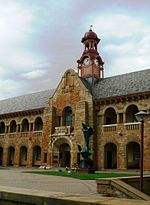 | |
| Abbreviation | FABI |
|---|---|
| Formation | 1997 |
| Founder | Mike Wingfield |
| Type | Research Institute |
| Location | |
Director | Bernard Slippers |
| Affiliations | University of Pretoria |
| Website | www |
The Forestry and Agricultural Biotechnology Institute (FABI) (Pretoria) was established in 1997 and is located on the University of Pretoria campus. The initial goal of the institute was to help the development of novel food and fibre crops, that will clearly contribute to global economic development and food security. Over the last decades the goals have expanded to cover a wide range of research fields. [1] [2]
Contents
- Primary Objectives
- Research Groups, Satellite Labs and International Programmes
- References
- External links
FABI was involved in 2011 in the completion of the eucalyptus tree genome ( Eucalyptus grandis ). [3]
